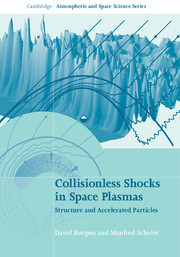Book contents
- Frontmatter
- Contents
- Preface
- Chapter 1 Shocks
- Chapter 2 Basic concepts
- Chapter 3 The quasi-perpendicular shock: macrostructure
- Chapter 4 The quasi-perpendicular shock: microstructure
- Chapter 5 The quasi-parallel shock
- Chapter 6 Diffusive shock acceleration
- Chapter 7 Coherent shock acceleration
- Chapter 8 Electron acceleration
- Chapter 9 Global and modified shocks
- Appendix Simulation techniques
- References
- Further reading
- Index
Chapter 9 - Global and modified shocks
Published online by Cambridge University Press: 05 August 2015
- Frontmatter
- Contents
- Preface
- Chapter 1 Shocks
- Chapter 2 Basic concepts
- Chapter 3 The quasi-perpendicular shock: macrostructure
- Chapter 4 The quasi-perpendicular shock: microstructure
- Chapter 5 The quasi-parallel shock
- Chapter 6 Diffusive shock acceleration
- Chapter 7 Coherent shock acceleration
- Chapter 8 Electron acceleration
- Chapter 9 Global and modified shocks
- Appendix Simulation techniques
- References
- Further reading
- Index
Summary
Introduction
For most of this book we have treated collisionless shocks as planar infinitely extended discontinuities with upstream plasma parameters characteristic for the solar wind, possibly corrugated by instabilities. However, all shocks in the solar system are curved and consequently the angles θBn, between the magnetic field and shock normal, and θVn, between the upstream plasma flow and shock normal, change along the shock surface. Ions backstreaming from a certain part of a shock can excite upstream waves which can be convected into other parts of the shock, where they may influence the shock structure. This is of particular importance for planetary bow shocks, where the region upstream of the quasi-perpendicular part of the shock can interact further downstream with the quasi-parallel part of the shock. In addition, the decrease in θVn, toward the flanks results in considerable variation of the shock strength along the bow shock. In Section 9.2 we will discuss results on global bow shock simulations and, in Section 9.3, the influence of bow shock curvature on upstream escaping electrons.
In Chapter 6 it was described how particles can be accelerated to very high energies by the converging flows in shocks. The maximum energy is ultimately only limited by the finite spatial extent of the shock or by the maximum time available for the diffusive shock acceleration mechanism to work. The pressure in the accelerated particles in the upstream region can become very high and can even exceed the thermal particle pressure. This will lead to considerable modification of the shock structure. Although probably not important for shocks in the solar system, we will briefly outline in Section 9.4 the methods which have been used in order to treat shocks mediated by energetic particles which have, in turn, been produced by these shocks. As stated before, we are not so much concerned with the energetic particles (cosmic rays), but with the influence these may have on the shock structure.
Before reaching the heliopause where the solar wind pressure is balanced by the pressure of the local interstellar medium, the solar wind is slowed from a super-fast mode speed flow to a sub-fast mode speed flow at the heliospheric termination shock. The structure of the heliospheric termination shock might not be expected to be so different from other shocks in the solar system, if the upstream medium were much like the solar wind in the inner heliosphere. But the solar wind in the region of the termination shock carries with it a high percentage of pickup protons.
- Type
- Chapter
- Information
- Collisionless Shocks in Space PlasmasStructure and Accelerated Particles, pp. 296 - 325Publisher: Cambridge University PressPrint publication year: 2015

